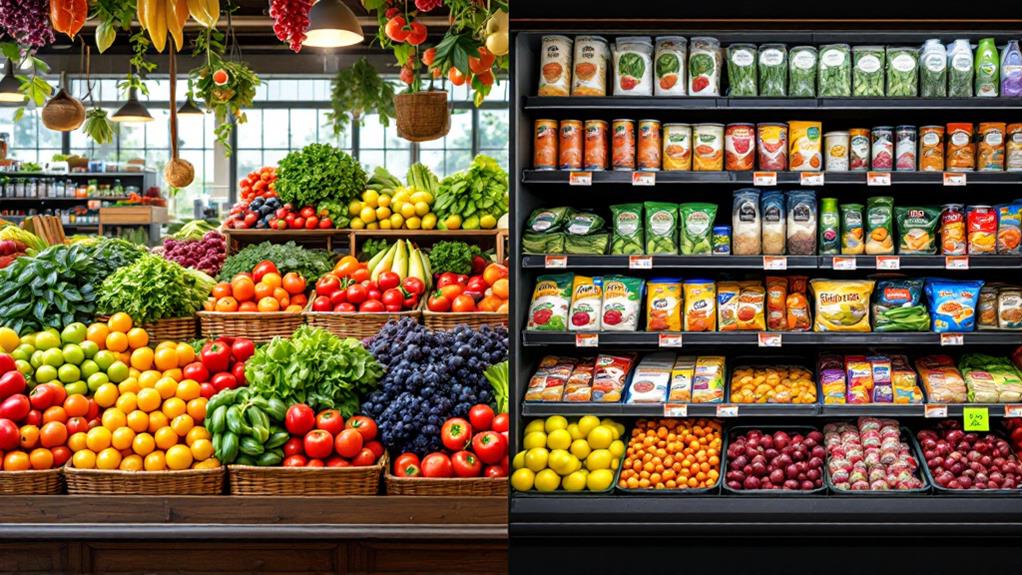Is Granola a Healthy Choice? Nutritional Facts You Need to Know
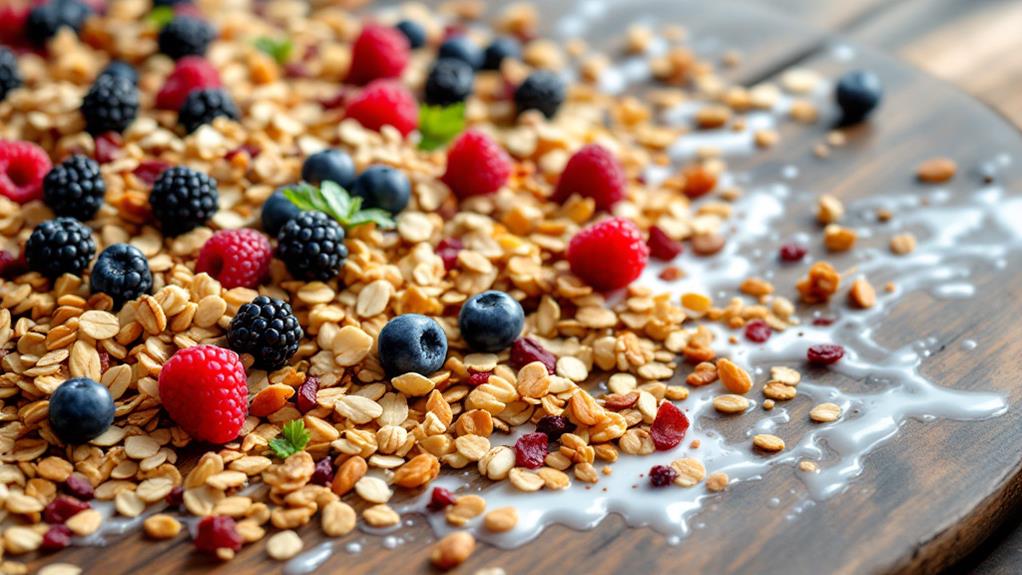
Granola can indeed be a healthy choice, but it depends on what you pick. Look for granolas with whole grains like oats, minimal added sugars (ideally 5g or less), and plenty of fiber—aim for at least 5 grams per serving. Be cautious of high saturated fat, often from coconut oil, as it can rise to 10.5g in some brands. A typical half-cup serving provides about 5g each of protein and fiber, supporting digestion and sustaining energy. Check the ingredients for transparency and avoid fillers. If you're curious about maximizing granola's health benefits, there's more to uncover.
Understanding Granola Basics
In regard to understanding granola, you'll find it's a versatile and nutritious choice for many. Granola is primarily made from rolled oats, combined with sweeteners like honey or maple syrup, nuts, seeds, and sometimes dried fruits. It's a crunchy cereal that can be enjoyed as a breakfast staple, a yogurt topping, or a convenient snack. While granola is often considered healthy due to its inclusion of whole grains and fiber, it's important to be mindful of added sugars and calories.
A typical serving size of granola, about half a cup, packs approximately 202 calories. This serving provides around 5 grams of protein and 5 grams of fiber, contributing to its satisfying nature. However, the nutritional profile of granola can vary greatly across brands. Some brands might contain up to 11 grams of added sugars per serving, making it vital to read the nutrition label carefully.
Opting for homemade granola allows you to control the ingredients and sugar content, ensuring a healthier choice. This way, you can enjoy the benefits of whole grains, nuts, seeds, and dried fruits without unnecessary additives. By understanding these basics, you can make informed decisions about incorporating granola into your diet.
Nutritional Components
When you're choosing granola, understanding its nutritional components is vital to making a healthy choice. A typical ½ cup serving contains about 202 calories, so keeping an eye on the calories per serving is important if you're watching your intake. Granola can be a good source of protein and fiber, providing around 5g of protein and up to 5g of fiber per serving. These components help with digestion and keep you feeling full longer.
One thing to watch out for is the sugar content. Some brands have up to 11g of added sugars, so it's important to read the nutrition label to find options with lower sugar levels. Granola often includes healthy fats from nuts and seeds, which contribute beneficial fats to your diet. However, be mindful of the saturated fat content, which may go up to 10.5g in some varieties.
Granola is rich in vitamins and minerals, such as iron, magnesium, and potassium, which support general health. Choosing granola made from whole foods can improve its nutritional value. Here's what to look for:
- Calories per serving
- Protein and fiber content
- Added sugars
- Healthy fats from nuts and seeds
- Vitamins and minerals
Health Benefits
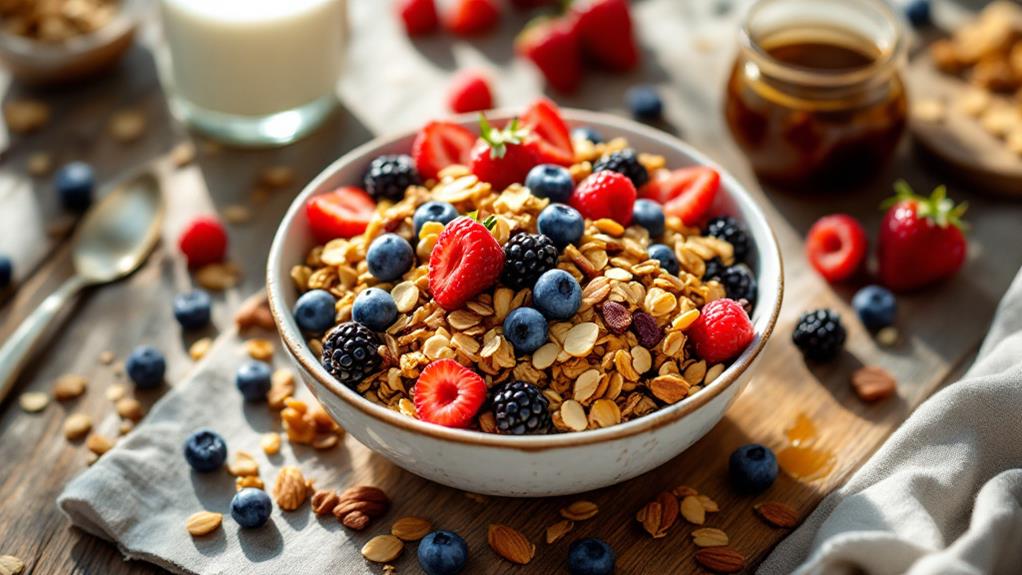
Granola offers a range of health benefits that make it a valuable improvement to your diet. Packed with fiber, a typical serving provides about 5 grams, which aids digestion and promotes satiety, helping you control your appetite throughout the day. The whole grains, particularly oats, are beneficial as they contain beta-glucan—a soluble fiber known to lower LDL cholesterol levels by around 4% with daily consumption. This reduction can greatly support heart health.
In addition to fiber, granola is a great source of crucial nutrients like iron, magnesium, and potassium. These contribute to general well-being by supporting different bodily functions. Furthermore, the antioxidants in the nuts, seeds, and dried fruits found in granola may help reduce inflammation and oxidative stress, further improving your health.
The combination of whole grains, protein, and healthy fats in granola provides sustained energy, making it an excellent choice for breakfast or snacks. However, while enjoying granola's health benefits, be mindful of added sugars in some store-bought varieties, as excessive amounts can negate its positive effects. Opt for versions with minimal added sugars to optimize granola's health potential.
Potential Drawbacks
While granola boasts numerous health benefits, it's essential to be aware of its potential drawbacks, especially the calorie content. Some granolas can be calorie-dense, with up to 260 calories per serving. If you're not careful with portion sizes, it's easy to consume more than intended. Store-bought granola often contains high added sugars, sometimes exceeding 11 grams per serving, far above the recommended 5 grams for a healthier choice. This high sugar content can contribute to potential health risks, such as obesity or diabetes.
Moreover, the ingredient list in some granola brands features added fats from items like coconut oil, which can contribute to high saturated fat levels. Some have as much as 10.5 grams per serving. Be on the lookout for ingredients like chicory root, which are fillers and don't offer the benefits of whole food fibers. This can lead to misconceptions about granola being universally healthy, masking potential health risks. Always read the ingredient list carefully.
Here are some key points to keep in mind:
- High calories per serving
- Excessive added sugars
- Saturated fat content
- Use of fillers over whole food fibers
- Variation in ingredient quality between brands
Comparing Granola Types
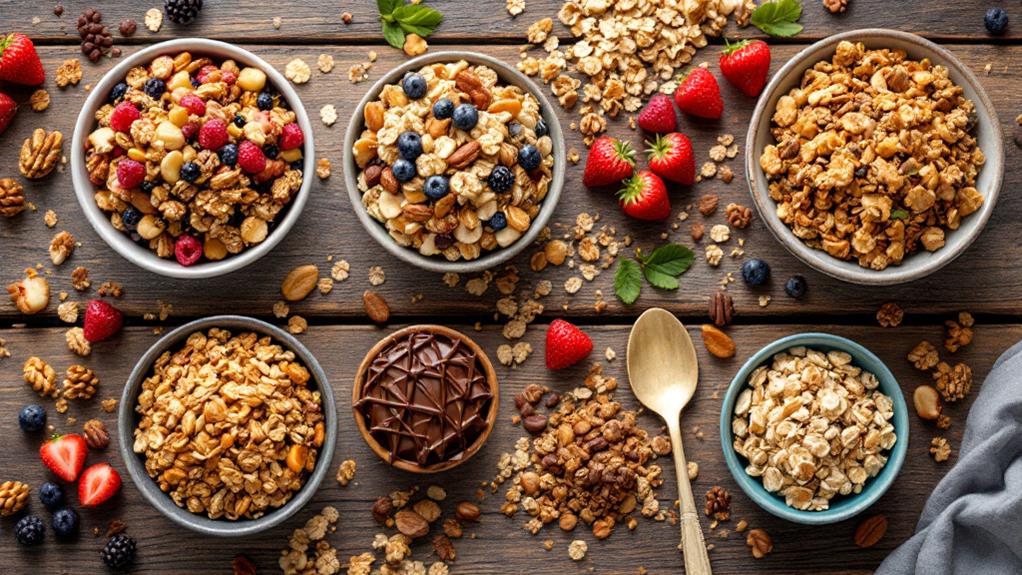
In the world of granola, variety is abundant, and not all options are created equal. When choosing between granola types, you'll notice significant differences in calorie content. For example, Kelloggs Low Fat Granola offers around 195 calories per serving, whereas Gypsy Crunch Roasted Granola can have up to 260 calories. These numbers matter if you're watching your intake. Added sugars are another important factor; some granolas pack over 11 grams per serving, while healthier choices keep it under 5 grams. It's vital to pay attention to these details to maintain a balanced diet.
Nutritional profiles vary as well. A typical granola serving includes about 5 grams of protein and fiber, but some brands excel in these areas, offering even more. Granolas rich in healthy ingredients like whole oats, nuts, and seeds are preferable. They provide necessary nutrients and are generally more beneficial than those loaded with unhealthy fats such as coconut oil.
Consider making homemade granola for greater customization. This way, you control sugar levels and guarantee the inclusion of wholesome ingredients, tailoring it to your dietary needs. By doing so, you'll likely find a healthier alternative to many store-bought options.
Decoding Ingredient Labels
When you're steering through the world of granola, understanding ingredient labels is important for making healthier choices. Start by prioritizing granolas that list whole grains like rolled oats as the initial ingredient. This guarantees you're getting the most nutritional value and health benefits from your selection. Be vigilant about added sugars; aim for granolas with 5 grams or less per serving to keep those health benefits intact.
Fiber content is another significant factor. Look for granolas with at least 3 to 5 grams of fiber per serving to aid digestion and promote feelings of fullness. Saturated fats should also be on your radar, especially if they come from coconut oil, as they can increase your calorie intake and pose health risks.
Ingredient sourcing is important—choose granolas with transparent, simple ingredients. This means avoiding unnecessary fillers or additives that can detract from the nutritional value.
Keep these tips in mind:
- Whole grains: Confirm rolled oats are the initial ingredient.
- Added sugars: Limit to 5 grams or less per serving.
- Fiber content: Seek 3 to 5 grams per serving.
- Saturated fats: Avoid high levels.
- Simple ingredients: Confirm transparency in sourcing.
Selecting Healthy Options
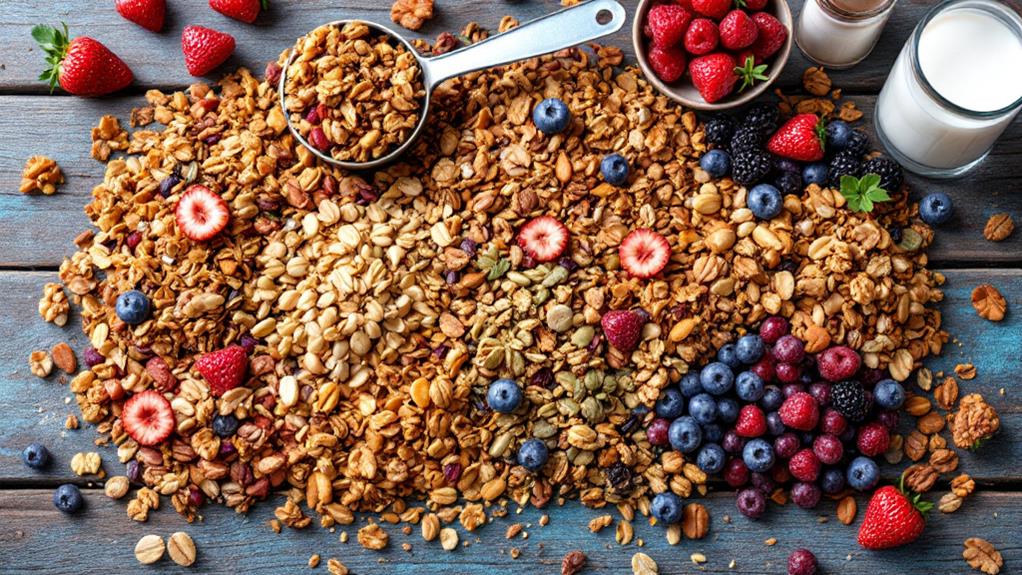
Choosing the right granola can greatly impact your health, so let's focus on what matters most. Start by checking the ingredients list and prioritize granolas with whole oats or grains as the primary ingredient. This guarantees a higher nutritional value and enhances fiber content, which is crucial for digestive health. A healthy granola should contain at least 3-5 grams of fiber and protein per serving to keep you full and satisfied.
Next, scrutinize nutrition labels for added sugars. Aim for granolas with no more than 5 grams of sugar per serving. Excessive sugar can easily negate any health benefits you're seeking. The same attention should be given to fats. Look for options with minimal added fats, ideally keeping saturated fat below 2 grams per serving. This aids in maintaining a balanced and nutritious diet.
Homemade Granola Tips
Crafting your own granola at home offers numerous benefits, allowing you to tailor the ingredients to suit your nutritional needs. By starting with whole oats, you guarantee a high fiber content, which is great for digestive benefits. Aim for 3-5 grams of fiber per serving to keep things moving smoothly. Adding a variety of nuts and seeds, such as almonds and chia seeds, raises protein levels, giving you at least 5 grams per serving. This nutritious blend not only satisfies hunger but also provides vital nutrients.
To keep your homemade granola healthy, limit added sugars. Opt for natural sweeteners like honey or maple syrup, making sure total added sugars stay below 5 grams per serving. This choice helps you control calories while still delivering delicious flavor. You can also experiment with spices like cinnamon or vanilla extract to improve the taste without piling on extra sugar.
Remember, portion size matters. Stick to about 1/4 to 1/2 cup per serving to avoid overconsumption of calories and sugars. Here are some tips to keep in mind:
- Use whole oats for high fiber content
- Include a variety of nuts and seeds
- Choose natural sweeteners
- Experiment with spices
- Measure portion sizes
Granola in a Balanced Diet
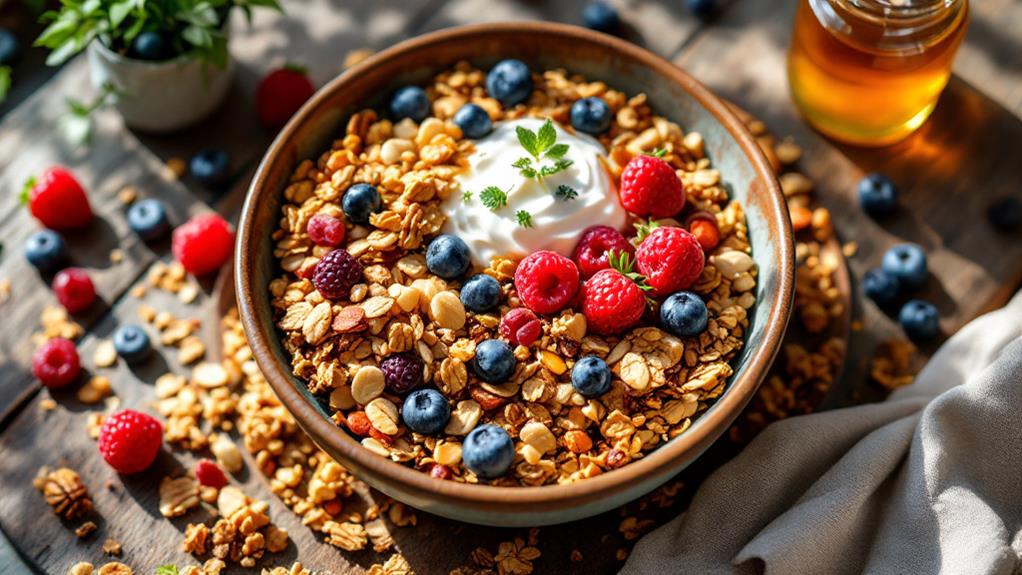
Investigate how granola can seamlessly fit into a balanced diet by adding vital nutrients like fiber, protein, and healthy fats. It's a healthy choice when consumed in moderation, supporting digestive health and keeping you full longer. A typical half-cup serving of granola contains about 202 calories, 5g of protein, and 5g of fiber, making it both satisfying and nutritious. However, to optimize its benefits without tipping your calorie balance, you need to practice portion control.
Choosing the right granola is key. Look for options with low added sugars—ideally under 5g per serving—and high fiber content, at least 4g per serving. This guarantees you're getting the best nutritional value without unnecessary sugars that can spike your daily intake. Pairing granola with yogurt or fresh fruits can further improve its nutritional value, delivering extra protein, vitamins, and minerals necessary for a well-rounded meal.
Market Trends and Innovations
Incorporating granola into your diet doesn't just offer nutritional benefits; it also taps into a dynamic market teeming with creativity and trends. The demand for healthier options has made granola bars a go-to snack, with brands crafting exciting flavors and focusing on nutritional transparency. You can find varieties low in added sugars, featuring whole grains and nut butters, which cater to those conscious of the health effects of their snacks.
DIY granola recipes are also trending, giving you control over ingredients and sugar content, making them a healthier home-cooked alternative. As ingredients vary, you can customize your granola to suit your dietary needs and preferences. The market trends are steering towards minimal ingredient lists, ensuring that snacks are not just calorically dense but also nutritious.
Here's what to watch for in the granola market:
- Granola bars: Convenient and creative, perfect for snacking.
- Low in added sugars: Prioritizing ingredients that support your health.
- Whole grains and nut butters: Key components for balanced nutrition.
- DIY granola recipes: Personalize your granola experience.
- Nutritional transparency: Brands are focusing on clear labeling and healthy ingredients.
These trends highlight a shift towards healthier, more transparent dietary choices.

